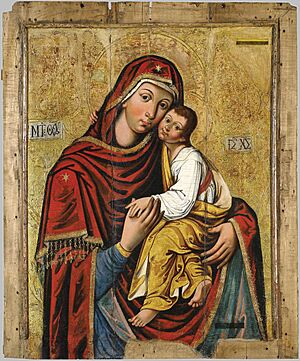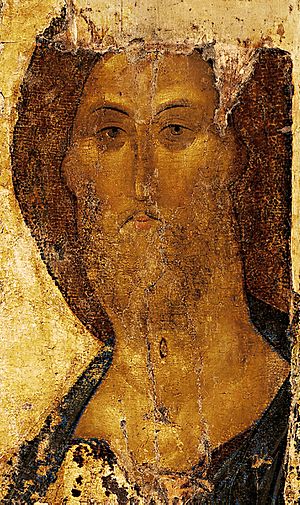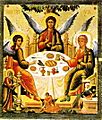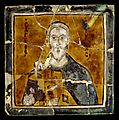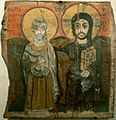Icon facts for kids
An icon (from the Greek language word eikon, meaning "image") is a special picture or image that has a religious meaning. It's like a sign or a likeness that stands for a real holy person or object.
While the word icon can be used for images in other religions, it most often describes a painting on a wooden panel. These paintings are made in the Orthodox Christian tradition. Icons can also be carved from ivory or made from silver or gold.
These holy icons usually show Jesus, Mary, a saint, or an angel. They can also show important scenes from the Bible, like the Crucifixion, or moments from the lives of saints. In Orthodox Christianity, an icon is seen as a window. Through this window, people believe they can get a glimpse of God's truth.
Contents
How Christian Orthodox Icons are Painted
The traditional way of making an icon has a long history. It was first used in ancient Egypt to create portraits of people who had died. These funeral portraits were painted on wooden panels, and the paint was mixed with egg yolk. This method was later adopted by artists for painting holy pictures after Christianity became legal around the early 300s.
Artists wanted their paintings to last a very long time. So, everything had to be prepared with great care. They chose a wooden board that would not crack or bend. The board was sanded smooth. Then, it was covered with a special gluey paint called "size." This layer helped the colors stick well and stopped the expensive paints from soaking into the wood.
The artists prepared their paints very carefully. Some colors came from grinding up semi-precious stones. Other colors were made from different chemicals.
Designing an Icon
Before painting on the panel, the artist had to prepare the design. It was not important for the artist to create something completely new. Instead, it was much more important to copy another icon very exactly. The same designs were used over and over again for centuries.
Some icons were believed to have special powers. People thought that praying and lighting candles in front of these icons could bring healing. They also believed it could bring help from the saint shown in the picture. These icons became very famous, and many copies were made of them.
Painting and Finishing an Icon
After drawing the design onto the prepared wooden surface, the artist would add the paint in many thin layers. They built up the colors bit by bit. Most of the colors were a bit see-through, which made the finished painting look like it was glowing.
When the figures were complete, the artist would place the work in a wooden frame. Then, they would "gild" it. This meant covering the background with tiny pieces of gold leaf. Gold leaf is gold that has been hammered into very thin sheets. When a candle was lit near the icon, its light would shine on the gold. This made the figures in the painting stand out beautifully.
Icons in Other Religions
Throughout history, some religions have often used images like paintings and statues. Examples include Christianity and Hinduism. However, other religions, such as Judaism and Islam, do not often use images of people.
In Hinduism, sacred objects are used a lot. This is because of a belief called murti. This idea suggests that the Spirit of God can be present in an icon or other holy object.
See also
Images for kids
-
The Ladder of Divine Ascent icon. It shows monks climbing towards Jesus in Heaven. This icon is from the 12th century and is at Saint Catherine's Monastery.
-
A Russian icon of the Holy Trinity.
-
The icon of St Nicolas carved in stone. It was made between the 12th and 15th centuries at Radomysl Castle, Ukraine.
-
Luke painting the Theotokos of Vladimir (16th century, Pskov).
-
Christ and Saint Menas, a 6th-century Coptic icon from Egypt (Musée du Louvre).
-
The oldest surviving icon of Christ Pantocrator. It was made using encaustic on panel around the 6th century (Saint Catherine's Monastery, Mount Sinai).
-
A 12th-century icon of Archangel Gabriel from Novgorod. It is called The Angel with Golden Hair and is now in the State Russian Museum.
-
The "Theotokos of Vladimir" icon (12th century), a symbol of Russia.
-
St Peter, made with encaustic on panel around the 6th century (Saint Catherine's Monastery).
-
A key piece of Palaiologan-era mannerism—the Annunciation icon from Ohrid in North Macedonia.
-
An Ethiopian Orthodox painting of the Virgin Mary nursing the infant Christ.
-
A detailed Eastern Orthodox icon corner, like one you might find in a private home.
-
A precious Russian icon of Joy of All Who Sorrow, from 1862.
-
This Italo-Byzantine work by a medieval Sicilian master shows careful attention to the throne and other details.
-
Muscovite Mannerism: Harrowing of Hell, by Dionisius and his workshop.
-
A Western-style icon of the archangel Michael in the Greek Catholic Iconostasis of the Cathedral of Hajdúdorog.
-
An icon of the Black Madonna of Częstochowa, one of the national symbols of Poland.
-
An icon of the Melanesian Brotherhood martyrs at Canterbury Cathedral (Anglican Communion).
See also
 In Spanish: Icono (religión) para niños
In Spanish: Icono (religión) para niños


